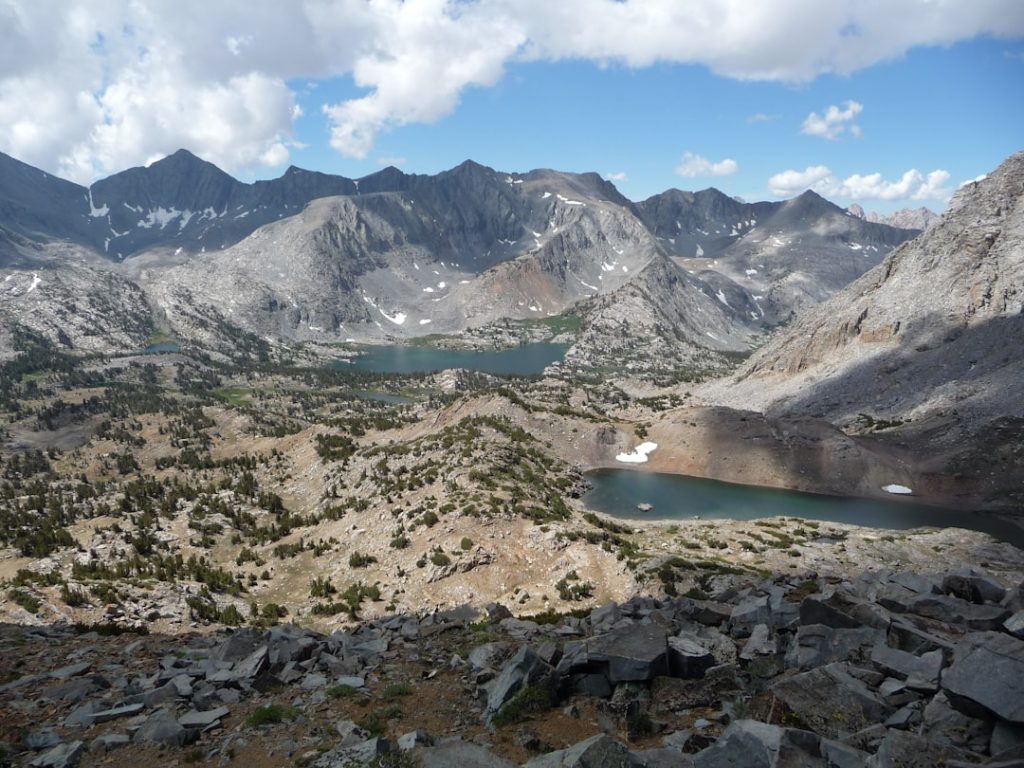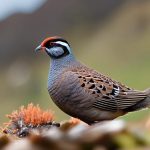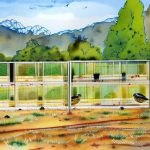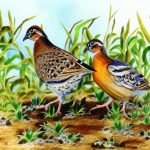The breeding season for mountain quail typically occurs in the spring and early summer months, with the exact timing varying depending on the specific region and climate. During this time, male mountain quail engage in elaborate courtship displays to attract females, and pairs form to begin the nesting process. This period is crucial for the survival and growth of mountain quail populations, as it is when new generations are produced to sustain the species. Understanding the breeding season of mountain quail is essential for conservation efforts and ensuring the long-term viability of these birds in their natural habitats.
The breeding season is a time of heightened activity and energy for mountain quail, as they engage in behaviors such as courtship displays, nest building, and egg laying. It is a critical period for the species, as successful breeding directly impacts population numbers and genetic diversity. By studying the breeding season of mountain quail, researchers and conservationists can gain valuable insights into the factors that influence breeding success and develop strategies to support healthy populations. As such, the breeding season of mountain quail is a key focus for wildlife management and conservation efforts aimed at protecting these iconic birds.
Table of Contents
- 1 Nesting and Mating Behavior of Mountain Quail
- 2 Factors Affecting Mountain Quail Breeding Success
- 3 Importance of Habitat for Mountain Quail Breeding
- 4 Conservation Efforts for Mountain Quail Breeding Season
- 5 Challenges and Threats to Mountain Quail Breeding
- 6 Future Outlook for Mountain Quail Breeding Season
- 7 FAQs
- 7.1 What is the breeding season for mountain quail?
- 7.2 Where do mountain quail typically breed?
- 7.3 How do mountain quail attract mates during breeding season?
- 7.4 How many eggs do mountain quail typically lay during breeding season?
- 7.5 What is the role of the male mountain quail during the breeding season?
- 7.6 What are some threats to mountain quail during the breeding season?
Key Takeaways
- Mountain quail breeding season typically occurs in the spring and early summer, with males engaging in elaborate courtship displays to attract females.
- Nesting and mating behavior of mountain quail involves the female selecting a well-hidden nest site and laying a clutch of 9-10 eggs, with the male standing guard nearby.
- Factors affecting mountain quail breeding success include predation, habitat loss, and climate change, which can impact food availability and nesting success.
- The importance of habitat for mountain quail breeding cannot be overstated, as they require dense shrub cover and a variety of plant species for foraging and nesting.
- Conservation efforts for mountain quail breeding season include habitat restoration, predator control, and public education to raise awareness about the species and its needs.
- Challenges and threats to mountain quail breeding include habitat fragmentation, invasive species, and human disturbance, which can disrupt breeding behavior and reduce reproductive success.
- The future outlook for mountain quail breeding season depends on continued conservation efforts and habitat protection, as well as addressing the various threats facing the species.
Nesting and Mating Behavior of Mountain Quail
During the breeding season, male mountain quail engage in elaborate courtship displays to attract females and establish pair bonds. These displays often involve vocalizations, such as distinctive calls and coos, as well as physical behaviors like strutting and wing-fluttering. Once pairs have formed, they begin the process of selecting a suitable nesting site and building a nest. The female mountain quail is primarily responsible for constructing the nest, which is typically a shallow depression on the ground lined with grasses, leaves, and other plant materials.
After the nest is constructed, the female will lay a clutch of eggs, which she will then incubate for approximately three weeks. During this time, the male may remain nearby to defend the nesting territory and provide food for the female. Once the eggs hatch, both parents will care for the young, leading them to food sources and protecting them from potential predators. The nesting and mating behaviors of mountain quail are fascinating to observe and study, providing valuable insights into the reproductive biology and social dynamics of these birds.
In addition to courtship displays and nest building, mountain quail also engage in complex mating behaviors that are essential for successful reproduction. These behaviors often involve intricate rituals and interactions between males and females, as well as competition among males for access to mates. Understanding these mating behaviors is crucial for conservation efforts, as it can help identify potential threats to breeding success and inform strategies for protecting mountain quail populations during this critical time.
Factors Affecting Mountain Quail Breeding Success
Several factors can influence the breeding success of mountain quail, including habitat quality, food availability, predation pressure, and environmental conditions. High-quality habitat with suitable cover, food sources, and nesting sites is essential for supporting healthy populations of mountain quail during the breeding season. Inadequate habitat can limit breeding success by reducing nesting opportunities and increasing vulnerability to predators.
Food availability is another critical factor that can impact breeding success, as mountain quail require a diverse diet of seeds, insects, and vegetation to support their reproductive efforts. A lack of food resources can lead to reduced body condition and lower reproductive output, ultimately affecting population growth. Predation pressure from natural predators such as raptors, snakes, and mammals can also pose a significant threat to breeding success, particularly during the vulnerable stages of nest building, egg laying, and chick rearing.
Environmental conditions such as weather patterns and climate variability can also influence breeding success for mountain quail. Extreme weather events, droughts, or unseasonable temperatures can disrupt nesting activities and impact chick survival rates. Understanding these factors and their interactions is crucial for managing and conserving mountain quail populations during the breeding season.
Importance of Habitat for Mountain Quail Breeding
Habitat plays a crucial role in supporting successful breeding for mountain quail, providing essential resources such as food, cover, nesting sites, and protection from predators. High-quality habitat with diverse vegetation types, including grasslands, shrublands, and forest edges, can offer suitable foraging opportunities and nesting locations for mountain quail during the breeding season. Additionally, habitat connectivity is important for facilitating movement between different areas and maintaining genetic diversity within populations.
Conserving and restoring habitat for mountain quail is essential for ensuring their long-term survival and reproductive success. This can involve activities such as habitat restoration, invasive species management, and land-use planning to protect critical areas from development or habitat degradation. By prioritizing habitat conservation efforts, we can create landscapes that support healthy populations of mountain quail during the breeding season and throughout the year.
Furthermore, habitat management practices such as prescribed burning, grazing management, and vegetation thinning can help create diverse habitat structures that benefit mountain quail. These practices can promote the growth of native plants, create open spaces for foraging, and maintain suitable cover for nesting and brood-rearing activities. By addressing the specific habitat needs of mountain quail during the breeding season, we can enhance their reproductive success and contribute to population recovery efforts.
Conservation Efforts for Mountain Quail Breeding Season
Conservation efforts for mountain quail during the breeding season encompass a range of strategies aimed at protecting critical habitats, reducing threats, and supporting healthy populations. These efforts often involve collaboration between government agencies, non-profit organizations, landowners, researchers, and local communities to address the complex challenges facing mountain quail populations. One key conservation approach is to identify and protect important breeding areas through land acquisition, conservation easements, or habitat management agreements.
In addition to habitat protection, conservation efforts may also focus on addressing specific threats to breeding success such as predation, invasive species, habitat loss, and climate change. This can involve implementing predator control measures in targeted areas to reduce nest predation rates or conducting research on the impacts of invasive plants on mountain quail habitat. Furthermore, education and outreach programs can raise awareness about the importance of conserving mountain quail breeding habitats and engage local communities in stewardship activities.
Research plays a crucial role in informing conservation efforts for mountain quail breeding season by providing valuable data on population trends, habitat requirements, reproductive biology, and threats to breeding success. By conducting field studies, monitoring populations, and analyzing ecological data, researchers can contribute essential information that guides conservation planning and management decisions. Ultimately, effective conservation efforts for mountain quail breeding season require a multi-faceted approach that addresses both immediate threats and long-term habitat needs.
Challenges and Threats to Mountain Quail Breeding

Mountain quail face numerous challenges and threats during the breeding season that can impact their reproductive success and population viability. Habitat loss and fragmentation due to urban development, agriculture expansion, logging activities, and infrastructure development can reduce available nesting sites and food resources for mountain quail. Fragmented habitats can also increase isolation among populations and limit genetic exchange between individuals.
Invasive species pose another significant threat to mountain quail breeding success by altering native plant communities, reducing food availability, and creating unsuitable habitat conditions. Invasive plants such as cheatgrass or Himalayan blackberry can outcompete native vegetation and degrade important foraging areas for mountain quail. Additionally, predation by introduced species such as feral cats or foxes can increase nest predation rates and negatively impact chick survival during the breeding season.
Climate change presents a growing threat to mountain quail breeding success by altering precipitation patterns, temperature regimes, and vegetation dynamics in their habitats. These changes can affect food availability, nesting conditions, and chick survival rates, ultimately impacting population dynamics. Understanding these challenges and their interactions is essential for developing effective conservation strategies that address the complex threats facing mountain quail during the breeding season.
Future Outlook for Mountain Quail Breeding Season
The future outlook for mountain quail breeding season depends on our ability to address key challenges such as habitat loss, invasive species impacts, predation pressure, and climate change effects. By implementing targeted conservation actions that protect critical habitats, reduce threats, and support healthy populations of mountain quail during the breeding season, we can work towards ensuring their long-term viability in the wild. This may involve collaborative efforts to conserve key breeding areas, restore degraded habitats, manage invasive species impacts, and mitigate climate change effects.
Furthermore, continued research on mountain quail reproductive biology, population dynamics, habitat requirements, and threats will be essential for informing conservation planning and adaptive management strategies. By integrating scientific knowledge with on-the-ground conservation efforts, we can enhance our understanding of the factors influencing breeding success for mountain quail and develop effective solutions to support their recovery. Additionally, engaging local communities in conservation initiatives through education programs, outreach activities, and citizen science projects can foster stewardship values and promote sustainable coexistence with mountain quail.
Ultimately, the future outlook for mountain quail breeding season depends on our collective commitment to conserving their habitats and addressing the complex challenges they face in the wild. By working together to protect these iconic birds during this critical time of year, we can contribute to their continued presence in our natural landscapes for generations to come.
As the mountain quail breeding season approaches, it’s essential to provide a suitable environment for these beautiful birds. In a recent article on PoultryWizard, they discuss the importance of creating a comfortable and secure space for poultry with their A-frame chicken coop design. This article offers valuable insights into how to construct a coop that meets the specific needs of quails during their breeding season. Check out the article here to learn more about creating an ideal habitat for your mountain quail.
FAQs
What is the breeding season for mountain quail?
The breeding season for mountain quail typically occurs from late April to early July.
Where do mountain quail typically breed?
Mountain quail breed in dense, brushy areas with plenty of cover and access to water, such as chaparral, shrublands, and forested areas.
How do mountain quail attract mates during breeding season?
Male mountain quail attract mates by calling loudly and displaying their colorful plumage. They also perform courtship displays to attract females.
How many eggs do mountain quail typically lay during breeding season?
Female mountain quail typically lay between 9-10 eggs in a clutch, which they incubate for about 24-25 days.
What is the role of the male mountain quail during the breeding season?
The male mountain quail plays a role in defending the nesting territory and may also help with feeding and protecting the chicks once they hatch.
What are some threats to mountain quail during the breeding season?
Some threats to mountain quail during the breeding season include habitat loss, predation, and disturbance from human activities.
Meet Walter, the feathered-friend fanatic of Florida! Nestled in the sunshine state, Walter struts through life with his feathered companions, clucking his way to happiness. With a coop that’s fancier than a five-star hotel, he’s the Don Juan of the chicken world. When he’s not teaching his hens to do the cha-cha, you’ll find him in a heated debate with his prized rooster, Sir Clucks-a-Lot. Walter’s poultry passion is no yolk; he’s the sunny-side-up guy you never knew you needed in your flock of friends!







